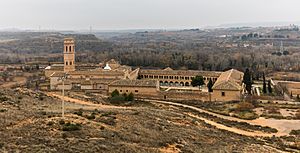Rueda Abbey facts for kids
Rueda Abbey, or Rueda de Ebro Abbey, is an old Cistercian monastery in Spain. It is also known as the "Royal Monastery of Our Lady of the Wheel." This historic site is located in Sástago, near the Ebro River, in the province of Zaragoza, Aragon. It is about 74 kilometers southeast of the city of Zaragoza. A monastery is a special place where monks, who are religious men, used to live and work together. Today, the Spanish government has carefully preserved these ancient buildings. They are now planned to be used as a hotel and a place for conferences.
Contents
A Look Back in Time
How It All Began
The Cistercian monks started their first monastery in Cîteaux, France, way back in 1089. From there, other monasteries were created, like Morimond Abbey in France in 1115. Monks from Morimond Abbey then founded Gimont Abbey in France in 1152.
Later, in 1162, these monks received land in Spain, near Zaragoza. However, they did not build their monastery there. In 1182, King Alfonso II of Aragon gave them even more land. This new land included a castle and village called Escatrón, located by the Ebro River. Finally, after more than 20 years, Rueda Abbey was founded. It was built right on the banks of the Ebro River, next to a river island and a salt lagoon.
Building the Abbey
The main construction of Rueda Abbey began around the early 1200s. The first church was finished and ready for use before 1238. The monks also built a special washing area called a lavatorium in the 13th century. The cloisters, which are covered walkways, were built with strong stone arches. By the early 1400s, the old Abbot's Palace, farm buildings, and areas for regular people were all complete.
From the very beginning, the monks were very clever with water. They built a dam on the Ebro River. They also created a huge waterwheel, which is where the name "Rueda" (meaning "wheel" in Spanish) comes from. This waterwheel helped move river water to a Gothic aqueduct. The aqueduct then sent water to different parts of the monastery. You can still see many of these water channels and pipes today! This amazing system was an early example of indoor plumbing and even a type of central heating.
The monks lived in an area that was not very populated. They developed many useful things for their community. These included a path for mules carrying salt, equipment for salt production, and a dock for boats on the river. They also had a special barge for transporting goods by mule on the river. The monks built an oil mill, a flour mill, and an irrigation ditch with a waterwheel. They even had a vineyard, a wine cellar, and an orchard surrounded by a protective wall.
Later Changes
More improvements and detailed rebuilding happened in the 1500s and 1600s. These changes were mostly around the main square. A beautiful Renaissance-style archway was added. This archway connected the medieval buildings to the Abbot's Palace. Behind this archway, new rooms for young monks and bedrooms were built.
The Royal Gateway, a large entrance structure, was built in the 1600s and 1700s. This gateway is still the main entrance to the entire abbey complex today.
Modern Times
In the 1830s, there were big changes in Spain. The government sold off many church lands and buildings, including Rueda Abbey. The site was then used for farming, and some parts of the abbey were damaged.
However, in 1990, the government of Aragon took control of the property. Since then, a lot of money has been spent on saving and restoring the abbey. Today, the restored parts include a three-star hotel and meeting rooms. The parts of the abbey from the Middle Ages have not been changed. More restoration work is planned for the future.
See also
 In Spanish: Monasterio de Nuestra Señora de Rueda para niños
In Spanish: Monasterio de Nuestra Señora de Rueda para niños




